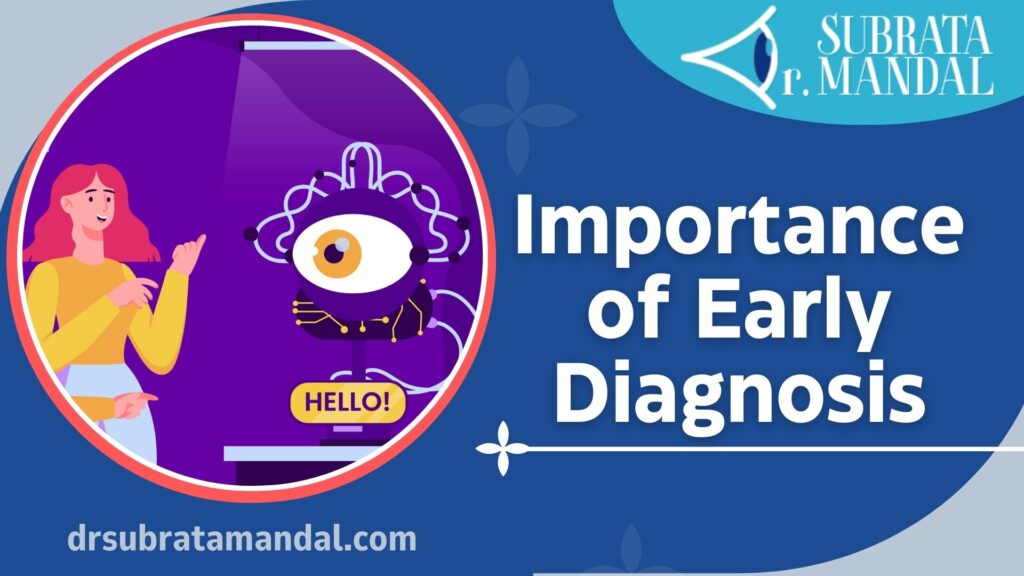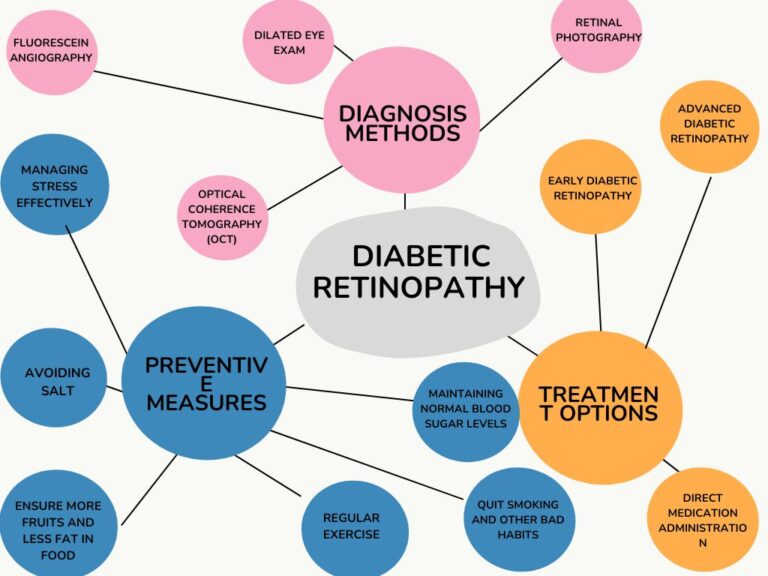What is
Diabetic Retinopathy
Diabetic Retinopathy is a complicated eye condition affecting diabetic people. Dependent on high levels of blood sugar, it causes damage to the retina. If neglected for long, this damage leads to vision issues, and eventually complete blindness. This disease progresses through a series of stages. Therefore, seeking an early diagnosis is the only way to curb the risks associated with it.
Types of Diabetic Retinopathy
Non-Proliferative Diabetic Retinopathy (NPDR)
Non-proliferative Diabetic retinopathy (NPDR) is the earliest stage of diabetic retinopathy. This condition is commonly observed in diabetic individuals. In this stage, retinal blood vessels start leaking which forces the retina to expand. This expansion leads to the swelling of the macula resulting in macular edema. Macular edema is the cause of blindness in diabetics.
Proliferative Diabetic Retinopathy (PDR)
Proliferative Diabetic Retinopathy (PDR) is the later stage of diabetic retinopathy. This condition is identified by the growth of blood vessels under the retina. Due to the delicate nature of these blood vessels, the risk of bleeding increases. This eventually leads to loss of vision. Therefore, immediate medical intervention is necessary if the condition is detected during the NPDR stage.

Importance of Early Diagnosis
Early diagnosis of diabetic retinopathy is of unparalleled importance as it helps in the prevention of complete blindness. Considering this, this condition is best identified by a comprehensive dilated eye exam. Further, direct ophthalmoscopy is also a cost-effective method of diagnosis with a success rate of approximately 80-90%.
Dr Subrata Mandal
Owner, Lead Optometrist
Diabetic Retinopathy Symptoms
It is very common for diabetic retinopathy to have no symptoms during its initial stages. However, as time goes on, one might start to experience:
- Worsening vision: Gradual decline in eyesight
- Patchy or blurry vision: Sudden vision changes and lack of clarity
- Redness in the eye: Stinging dry red eyes
- Poor night vision: Struggle to identify faces, and objects in low light or the dark
- Seeing floaters and dark spots: Tiny orbs and cobweb-like structures float across the vision field
- Struggle in color identification: Struggle in distinguishing between colors, their brightness, and shades
In case you struggle with any of the symptoms mentioned above, seek medical help at the earliest.
During the advanced stages of diabetic retinopathy, the earlier symptoms become more severe. These symptoms are usually seen during the proliferative stage. Some of them are:
- Severely blurred and patchy vision: Due to swelling of the retina, vision becomes poorer
- Distorted view: Straight lines start appearing wavy
- Intense pain in the eyes: This is caused by an increase in intraocular pressure
- Blind spots appear in the vision field: Blind spots and holes appear in the vision field
Seek quick medical attention if you observe any of the above symptoms.
Diabetic Retinopathy Treatment Options

Diagnosis Methods
For accurate detection of diabetic retinopathy undergoing an eye examination is of unparalleled significance. Some of the most common methods of diagnosis are:
- Retinal Photography: Here, a highly detailed image of the retina is captured to identify any signs of damage
- Dilated Eye Exam: This is a test where drops are given to expand the pupils. This helps in the detailed examination of the retina.
- Fluorescein Angiography: A dye is released into the circulation system. This dye highlights any abnormal blood vessels in the retina.
- Optical Coherence Tomography (OCT): This imaging technique provides a full fragmentary perspective of the retina. This helps identify diseases related to diabetes.
Treatment Options
The treatment options for diabetic retinopathy are heavily dependent on the type of diabetic retinopathy and its level of severity. Based on that, appropriate treatment procedures are selected to slow down the pace of the disease.
- Early diabetic retinopathy: In case a case of NPDR is detected, there is no necessity for immediate intervention. However, close monitoring is ensured.
- Advanced diabetic retinopathy: In case it is a case of PDR, immediate medical attention, and intervention is mandatory.
- Direct Medication Administration: In some cases, certain medications are administered directly if it is seen fit. These medications are called vascular endothelial growth factor inhibitors. Mostly they are injected into the vitreous body.
Preventive Measures
Diabetic retinopathy is not a curable disease. However, the listed preventive measures can prove to be useful. Some of them are:
- Maintaining normal blood sugar levels
- Quit smoking and other bad habits
- Regular exercise
- Avoiding salt
- Ensure more fruits and less fat in food
- Managing stress effectively
Although following these measures does not guarantee absolute safety from diabetic retinopathy, they can slow down the disease.
Notable Symptoms
-
Early Symptoms
-
Advanced Symptoms
Early Symptoms
Worsening Vision
Patchy or Blurry Vision
Redness In The Eye
Seeing Floaters And Dark Spots
Struggle In Color Identification
Advanced Symptoms
Severely Blurred And Patchy Vision
Distorted View
Intense Pain In The Eyes
Blind Spots Appear In The Vision Field
IMPRESSIVE SKILLS
Dr. Subrata Mandal is renowned for his exceptional expertise in ophthalmology, delivering top-tier eye care with precision and dedication. His deep knowledge, surgical excellence, and patient-centered approach make him one of the most trusted eye specialists.
WHY CHOOSE Dr. Mandal
There are a number of reasons why you should choose Dr. Subrata Mandal as your Best Diabetic Retinopathy Doctor in Kolkata. At present, he is the best diabetic retinopathy doctor in Kolkata. A reputed diabetic retinopathy expert, he has provided the right advice to his patients. Other than that, he also provides:
- Personalized treatment chart:- As a physician, Dr. Mandal is aware of customized treatment needs. He gives special attention to the issues faced by each patient and crafts a plan suited to meet their needs. This plan is modified as per further requirements.
- Treatment through the most advanced technologies:- One of the foremost goals of Dr. Mandal is to ensure effective patient care. He fulfills this by treatment with advanced technologies. Not only does it improve treatment outcomes, but it also enhances patient experiences.
- Committed to research and development:- Apart from being one of the best in his field, Dr. Mandal is a dedicated researcher, and academic. He realizes that current treatment options can only be improved through intense research. Up till now, Dr. Mandal has authored a book called New Investigations in Ophthalmology, published in 2006. Additionally, he has also contributed to fifteen academic, and research journals.
Book an Appointment
or Call +91 987 466 4924
click here to read more Reviews
What our Patient’s talking about Us?
Clinic is neat and clean, his prediction was good to caught disease, he does not prescribed much medicines.

Bidhan Saha
KolkataClinic is neat and clean, doctor is soft spoken, in this trying times of covid pandemic he followed necessary precautions from his end but he is as always a bit exorbitant

Prasenjit Majhi
KolkataFREQUENTLY ASKED QUESTIONS
FAQS
It’s a condition where high sugar in the blood causes damage to blood vessels.
Generally through a dilated eye exam.
Mild cases are treated through diabetes management. Advanced stages require surgery.
The cost of treating diabetic retinopathy in Kolkata varies based on the treatment method and severity of the condition. On average, expenses range from ₹22,000 to ₹80,000. Here’s a breakdown:
- Anti-VEGF and Steroid Injections: Approximately ₹22,000 to ₹45,000.
- Laser Treatment: Approximately ₹30,000 to ₹50,000.
- Surgical Procedures (e.g., Vitrectomy): Approximately ₹50,000 to ₹2,00,000.
The best treatment for diabetic retinopathy in Kolkata depends on the severity of the condition. Options include laser treatment (photocoagulation), intravitreal injections (anti-VEGF or steroids), and vitrectomy surgery for advanced cases. Leading eye specialists like Dr. Subrata Mandal offer expert care in Kolkata. Consult a retina specialist for personalized treatment.
Yes. Poor control over glycosylated hemoglobin makes you prone to diabetic retinopathy.
Yes. But you can slow down the disease if you maintain your control.
Yes, you are still at risk of vision loss.
Yes. Both compromised in time.


